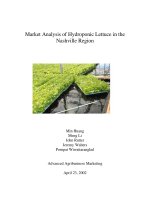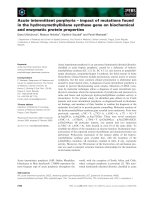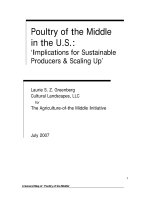Spatial-temporal Dynamics of Rubber Plantation in the Border Region of China, Laos and Myanmar: 1980-2010 pdf
Bạn đang xem bản rút gọn của tài liệu. Xem và tải ngay bản đầy đủ của tài liệu tại đây (2.42 MB, 21 trang )
Spatial-temporal Dynamics of Rubber
Plantation in the Border Region of China,
Laos and Myanmar: 1980-2010
Luguang Jiang, Zhiming Feng, Xiaona Liu,
Peng Li and Jinghua Zhang
Institute of Geographic Sciences and Natural Resources Research,
Chinese Academy of Sciences, Beijing, China, 100101
Outline
Background
RS Interpretation of Rubber Plantation
Spatial-temporal Pattern of Rubber
Plantation
Topographic Features of Rubber
Plantation
Summary and Prospect
Background
• Rubber plantation was
introduced to this region in 1940s.
• BRCLM is the key region of
opium poppy substitution planting
under international cooperation.
• Rubber, as the main cash crop
for opium poppy substitution
planting: more income for local
farmers, less drugs for the world.
The Border Region of China, Laos and Myanmar
BRCLM includes three
counties in southwest
Yunnan Province, China
(Jinghong City, Menghai
County, Mengla County),
three provinces in
northern Laos (Luang
Namtha Province,
Phongsaly Province,
Oudomxay Province), and
two districts in northeast
Myanmar (Kengtung
District, Mongphat District)
The region covers nearly 74 000 km2 with
2 million people living in the end of 2010.
BRCLM is a multi-ethnic region with more
than twenty ethnics living across borders.
Outline
Background
RS Interpretation of Rubber Plantation
Spatial-temporal Pattern of Rubber
Plantation
Topographic Features of Rubber
Plantation
Summary and Prospect
Interpretation of Rubber Plantation
• Remote sensing sources : Landsat MSS/ETM/TM images; MODIS
images.
• Time-series: 1980-1990-2000-2010
• DEM: GDEM (30m)
• Other data: Standard format of topographic maps with 1: 100000
scale;
Field survey samples of Xishuangbanna in 2010
• Based on MODIS-NDVI data, we analyzed phenological
characteristics of each vegetation coverage and determined the
temporal window for rubber detection.
• According to the spectral differences of rubber forest at different
age, young rubber forest (<10 years) and mature rubber forest(≥10
years) were extracted by object-oriented classification based on
analysis of spectral, texture, and other characteristics.
• Total classification accuracy was 82.5%, the accuracy of mature
rubber forest and young rubber forest were 92.50% and 76.42%.
Rubber Plantation: 1980 - 2010
Outline
Background
RS Interpretation of Rubber Plantation
Spatial-temporal Pattern of Rubber
Plantation
Topographic Features of Rubber
Plantation
Summary and Prospect
Current Spatial Pattern of Rubber Plantation
Overview:In 2010, rubber plantations covered 6187 km2, accounting
for 8.42% of study area, was the dominated land use type in BRCLM.
The proportion of mature rubber plantations (≥10 year) and young
rubber plantations (<10 year) was 4:6.
Pattern: Mainly distributed in Jihong City, Mengla County, partly in
Mongphat District, Ketung District and Luang Namtha Province,
Phongsaly Province.
Mature rubber forest: 2491 km2; 40.26%; mainly concentrated in
Jinghong City and Mengla County, and the border region of Mengla
and Menghai County.
Young rubber forest: 3696 km2 , 59.74%; dispersed surrounding mature
rubber forest, mainly distributed in regions adjacent to Menghai and
Mengla County.
Distribution Changes of Rubber Plantation
CHINA
MYANMAR
LAOS
Outline
Background
RS Interpretation of Rubber Plantation
Spatial-temporal Pattern of Rubber
Plantation
Topographic Features of Rubber
Plantation
Summary and Prospect
Relationship with elevation factor
Overview:
•Highest: 1044~1998m
•Lowest:453~423m
•Range:591~1575m
Higher
Lower
Wider
Change pattern:
•Main distribution interval: 400~1200m; over 4/5 concentrated in the
gradients of 600~1000m; rarely occurred in elevations beyond 1200 m.
•1980-2010: the proportion of rubber plantations area in the elevation of
600-800m decreased, while increased in the gradients of 800-1000 m.
•Rubber plantations showed an obvious characteristic of expanding to
higher (especially above 1000 m) and lower (below 600 m) elevations.
China (1980-2010):
•expanded to areas at higher
elevations with wider range of
expansion.
•increased gradually the
planted intensity.
Myanmar (1990-2010):
•expanded fluctuating around
the appropriate elevation
gradients of 600 ~800 m with
a wider elevation range.
•increased continually the
planted intensity.
Laos (2000-2010):
•expended to higher and lower
elevations surrounding
gradients of 600-800 m.
•increased the planted
intensity gradually.
1980
Elevation
(m)
1990
2000
Within
China
Within
Laos
Within
Myanm
ar
Within
China
Within
Laos
Within
Myanma
r
7.18
3.84
12.10
3.71
10.51
19.06
80.74
66.04
73.27
84.04
42.86
67.91
54.18
19.26
25.20
22.90
3.86
37.20
19.00
22.53
1.58
13.46
2.58
3.28
0.01
2.20
0.89
1400-1600
0.39
0.06
1600-1800
0.16
1800-2000
0.03
Within
China
Within
China
400-600
15.08
11.51
600-800
80.18
78.07
800-1000
4.73
10.30
1000-1200
0.01
0.13
Within
Myanm
ar
2010
1200-1400
Relationship with Slope Factor
Distribution:
•90% mainly distributed in slopes below 25°.
•nearly 2/3 concentrated in the appropriate slope gradients between 8°
and 25°.
•rarely occurred in slopes above 35°.
Change pattern (1980-2010):
•The area proportion of rubber plantations in slopes below 15°
declined, while in slopes beyond 15° increased.
•The expansion of rubber plantations mainly occurred between 15° and
35° and gradually extended in steep and abrupt slopes.
•The planted intensity of rubber plantations gradually increased at all
slopes with increase of 6.83% in gentle slopes and 4.06% in abrupt
slopes.
China (1980-2010):
•expanded gradually to areas at
higher slopes from gradients of
5-15° to gradients of 15-35° .
•had the highest planted intensity
and increased gradually in different
slope gradients.
•Myanmar (1990-2010):
•extended significantly in different
slope gradients.
•increased continually the planted
intensity with obvious growth in
recent 10 years especially.
•Laos (2000-2010):
•expanded obviously to higher
(>35°) and lower slopes (<5°)
with wider slope range in Laos.
•the planted intensity rose in
different slope gradients.
1980
Slope
(°)
1990
2000
2010
Within
China
Within
China
Within
Myanm
ar
Within
China
Within
Laos
Within
Myanm
ar
Within
China
Within
Laos
Within
Myanma
r
<5
19.02
16.17
8.10
12.30
12.50
15.69
9.41
17.25
12.92
5-8
18.86
16.90
11.93
13.92
12.50
17.65
11.52
17.10
14.38
8-15
37.00
36.26
47.36
34.17
37.50
35.29
31.95
35.10
33.65
15-25
21.23
24.87
25.60
29.88
25.00
25.49
33.52
24.36
29.27
25-35
3.57
5.21
7.01
8.46
12.50
5.88
11.51
5.45
8.54
>35
0.31
0.60
2.10
0.76
1.25
1.27
Relationship with Aspect Factor
Distribution:
•rarely distributed on flat aspect, while meanly distributed on other four
aspects.
•the planted intensity increased gradually in different aspect gradients.
•mainly distributed more on south and east aspects than on north and
west aspects, and the planted intensity showed the similar trend.
Change pattern (1980-2010):
•The proportion gradually declined on the flat and north aspects, while
rose continually on the south aspect, and decreased firstly then
increased on the east aspect which was opposite with the west aspect.
•The expansion mainly occurred on south aspect.
•The area continued to expand on east aspect, while declined on north
and west aspects.
China (1980-2010):
•expanded continually on south
and east aspects.
•increased the rubber planted
intensity at all aspects.
Myanmar (1990-2010):
•mainly distributed on south and
east aspects with expansion on
south and west aspects.
•increased the planted intensity in
all aspect gradients.
Laos (2000-2010):
•mainly distributed on south and
east aspects with expansion on
east and west aspects.
•rose planted intensity in all
aspect gradients.
1980
1990
2000
Within
Within
Myanm
China
ar
2010
Within
Within
Myanm
China
ar
Within
Laos
Within
Myanma
r
0.94
1.51
1.05
21.93
23.08
22.51
22.24
23.59
21.18
24.52
24.48
24.05
28.07
34.97
38.86
27.95
28.80
31.44
24.79
18.32
17.36
23.51
22.70
21.22
Aspect
Within
China
Within
China
Flat
1.24
1.16
4.05
1.00
0.97
0.69
North
23.45
23.55
11.42
23.01
22.16
East
23.21
23.03
50.83
23.12
South
26.68
27.22
33.69
West
25.42
25.05
0.00
Within
Laos
Outline
Background
RS Interpretation of Rubber Plantation
Spatial-temporal Pattern of Rubber
Plantation
Topographic Features of Rubber
Plantation
Summary and Prospect
Summary and Prospect
• Rubber plantations has been expanded to the areas of
higher elevations and steeper slopes in China. There are
considerable suitable land for rubber plantation in Laos and
Myanmar.
• A reasonable planning in the border region for rubber
plantation is needed, according to the current pattern of
rubber plantation and topographical conditions appropriate
for rubber planting.
• Pay more attention to the natural forest conservation, and to
balance the rubber production, natural forest conservation
and opium poppy substitution planting.
• Provide more fund and technical assistance for local farmers,
to raise profit at least negative ecological impacts.
- Rubber plantations in the border region of China, Laos and Myanmar
Thanks for Your Attention.
Contact Information:
Luguang Jiang, PhD, Associate Professor
Deputy Director, Division of Water and Land Resources,
Institute of Geographic Sciences and Natural Resources Research,
Chinese Academy of Sciences
Add: 11A, Datun Road, Chaoyang District, Beijing, 100101, China
E-mail: Tel: 86-10-64889467









